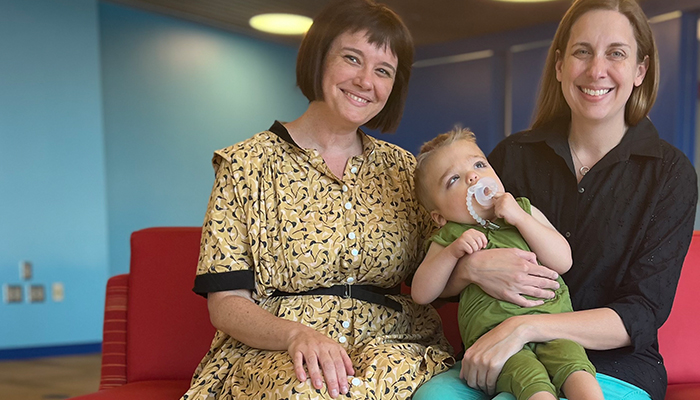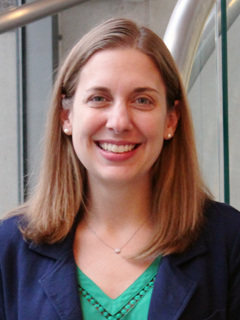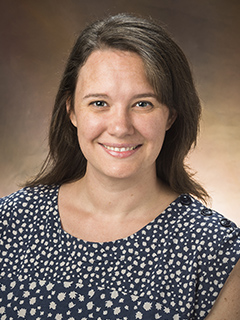HOW CAN WE HELP YOU? Call 1-800-TRY-CHOP
In This Section
Making Way for Gene Therapy in Rare Disease

Laura Adang. MD, PhD, (left) and Rebecca Ahrens-Nicklas, MD, PhD, holding one of their dear patients.
Dedicating the resources necessary to develop, test, and bring to the bedside a single gene therapy for an ultra-rare condition that affects only 30 to 40 patients around the world is a challenge that Children's Hospital of Philadelphia researchers are undertaking, as part of the Accelerating Medicines Partnership Bespoke Gene Therapy Consortium (AMP BGTC).
Rebecca Ahrens-Nicklas, MD, PhD, physician scientist in the Division of Genetics, and Laura Adang, MD, PhD, MSTR, attending physician in the Division of Neurology at CHOP, will lead the AMP BGTC study site for multiple sulfatase deficiency (MSD), an ultra-rare and devastating condition that robs children of their neurologic function. Their study team is among a select group who received grant support from the Foundation for the National Institutes of Health (FNIH) to develop first-in-human gene therapy trials and build a knowledge base about how to move gene therapies forward for eight rare conditions. The unique public-private partnership includes academic and industry leaders, the National Institutes of Health, and the U.S. Food and Drug Administration.

Rebecca Ahrens-Nicklas, MD, PhD
"What we learn from our roadblocks and successes in this model can be applied to the thousands of other ultra-rare conditions for which people are trying to develop gene therapy," Dr. Ahrens-Nicklas said. "It is an unprecedented opportunity to dismantle barriers and optimize care not only for MSD, but all rare diseases."
The BGTC will develop a rare disease clinical trial playbook that includes ideas for preclinical testing models, best practices for manufacturing a vector, and tips on how to interact with the FDA. This learning will occur in the public domain to increase the level of transparency about how to successfully take a gene therapy program through Investigational Drug Application and approval.
Natural History Study Provides Foundation for Future Research
Drs. Ahrens-Nicklas and Adang's work with the AMP BGTC is grounded in years of learning, relationship-building with patients and families, and collaboration with like-minded investigators. The colleagues turned friends first met each other at a pediatric residency welcome event, and they developed a shared interest in MSD, a genetic disorder that affects the SUMF1 gene.
MSD reduces the function of the formylglycine-generating enzyme which, in turn, affects the function of all cellular sulfatases. The resulting accumulation of molecular byproducts causes an ultimately fatal breakdown of the body, and there is currently no treatment available. Based on genotype and residual enzyme activity, there is a spectrum of clinical severity affecting children with MSD, ranging from attenuated to severe disease.
Drs. Ahrens-Nicklas and Adang launched a formal natural history study with the Leukodystrophy Center of Excellence at CHOP serving as the study's clinical home. The researchers gather information about MSD disease progression through medical records with urine and blood samples. Participants who receive clinical care at CHOP are invited to receive optional physical and occupational therapy assessments.
The symptoms of MSD, including neurologic deterioration, heart disease, hearing loss, and airway compromise, are progressive. A child may be developing along a typical trajectory, then quickly lose neurologic function over one to two years.
The natural history study has helped researchers to develop ways to predict and identify patients who are more likely to be in a severe group versus a less severe group, which Dr. Ahrens-Nicklas described as a game-changer. The researchers now have biomarkers that correlate to their findings about each patient's genetic change and the basic milestones children with MSD do or do not meet early on.
"We have learned so much about the genetics, biochemistry, and clinical progression of this disease," Dr. Ahrens-Nicklas said. "We are now able to evaluate a child early on and have a better understanding of how that child will be presenting in three to five years. Without that knowledge, we would not have been ready for a clinical trial. The effort over the past six years to compile that data in parallel with lab work to develop the gene therapy approaches came together at the right time for us to be able to successfully compete for the Bespoke grant."
Currently available clinical data support an in vivo gene therapy approach. Once underway, the clinical trial will use an adeno-associated viral vector to deliver gene replacement therapy into the cerebrospinal fluid to target the neurologic manifestations of MSD.
"We will first try this in vivo approach and hope that it is successful," Dr. Adang said. "But if it is not, we will be able to use that same comparator arm which we have rigorously designed and curated as a control for future clinical trials."
Potential for Early Diagnosis and Intervention
Prior knowledge about lysosomal storage diseases and leukodystrophies underscores the importance of early intervention to prevent disease progression in the brain. As they design a gene therapy trial and work toward definitive therapy, the researchers also aim to find ways of diagnosing children early and even presymptomatically.
MSD has the potential to be found through newborn screening , which often includes measurement of enzyme activity. It is the multiplicity of enzyme deficiencies that raises a red flag for MSD, since the condition affects enzyme function across all sulfatases.

Laura Adang, MD, PhD
"Families point to the journey to diagnosis as being the most stressful time," Dr. Adang said. "Irrespective of the development of transformative therapies, it's important to be able to guide families and triage care for them. More definitive newborn screening can give us an answer and guidance. Since we're also working on therapy at the same time, we can also give hope."
Supportive Partnerships
Dr. Ahrens-Nicklas and Dr. Adang credit the collaborative infrastructure at CHOP for support throughout the BGTC process. Chief Scientific Strategy Officer Beverly Davidson, PhD, first introduced the researchers to a parent of a child with MSD who was in search of scientific partnership and became a close friend. The Clinical In Vivo Gene Therapy team was instrumental to completing their grant application, and the Cell and Gene Therapy Collaborative provided support that moved their work forward.
In addition to their CHOP colleagues, the researchers are grateful to Lars Schlotawa, MD, international medical director of the United MSD Foundation, their partner for "all things natural history and for MSD trial design," and applaud Stephen Gray, PhD, director of the Translational Gene Therapy Core at UT Southwestern and Rachel Bailey, PhD for their development of the AAV9 MSD vector and critical pre-clinical animal model work to the benefit of the MSD community.
Most of all, Dr. Ahrens-Nicklas and Dr. Adang are thankful for the families who donate their time and effort so researchers can learn about each child and their disease progression.
"The families we have met find great meaning in being able to share their child's story and clinical features, because they know how important it is for the next generation of patients who are diagnosed with MSD," Dr. Adang said. "The opportunity to participate in the natural history study provides purpose to the families' journey with this disease and gives their child a legacy — they will not be forgotten."